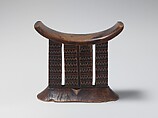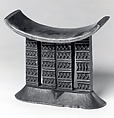Headrest
Not on view
The use of headrests in southern Africa has been traced back to the twelfth-century archaeological site of Mapungubwe, an urban center along the Limpopo River. There, evidence of gold sheeting believed to have adorned a long-disintegrated wood headrest has been recovered.
The designs of such works, created to protect elaborate coiffures, reflect a range of regional styles. Tsonga sculptors have been credited with the most varied formal solutions to the support element.
In Zulu society, women commissioned male carvers to produce a headrest for the bride and groom as part of the dowry. Among the Shona, headrests were exclusively carved and used by men. Since they also functioned as vehicles of communication with the ancestral realm, headrests and other personal articles were frequently buried with their owners, evidencing the intimate connection between the object and its owner. In other cases, they were passed along to male descendants.
This image cannot be enlarged, viewed at full screen, or downloaded.
This artwork is meant to be viewed from right to left. Scroll left to view more.



